มหัศจรรย์ยามค่ำคืน: ชมดาวที่อุทยานแห่งชาติอาร์เชส
ค้นพบความมหัศจรรย์ของท้องฟ้าทะเลทรายในยูทาห์ตะวันออกเฉียงใต้
สรุป
อุทยานแห่งชาติ Arches ซึ่งตั้งอยู่ทางตะวันออกเฉียงใต้ของรัฐยูทาห์ ห่างไกลจากแสงแดดจากเมืองใหญ่ มีท้องฟ้าที่มืดมิดที่สุดแห่งหนึ่งในสหรัฐอเมริกา ที่อุทยานแห่งชาติ Arches คุณจะสามารถมองเห็นดวงดาวมากมายด้วยตาเปล่า และหากอยู่ในสภาพแวดล้อมที่เหมาะสม คุณอาจมองเห็นวงแหวนของดาวเสาร์ได้ด้วยกล้องส่องทางไกลธรรมดา คู่มือนี้จะช่วยให้คุณเตรียมพร้อมสำหรับการผจญภัยบนท้องฟ้ายามค่ำคืนที่น่าประทับใจซึ่งไม่เหมือนใครที่อุทยานแห่งชาติ Arches
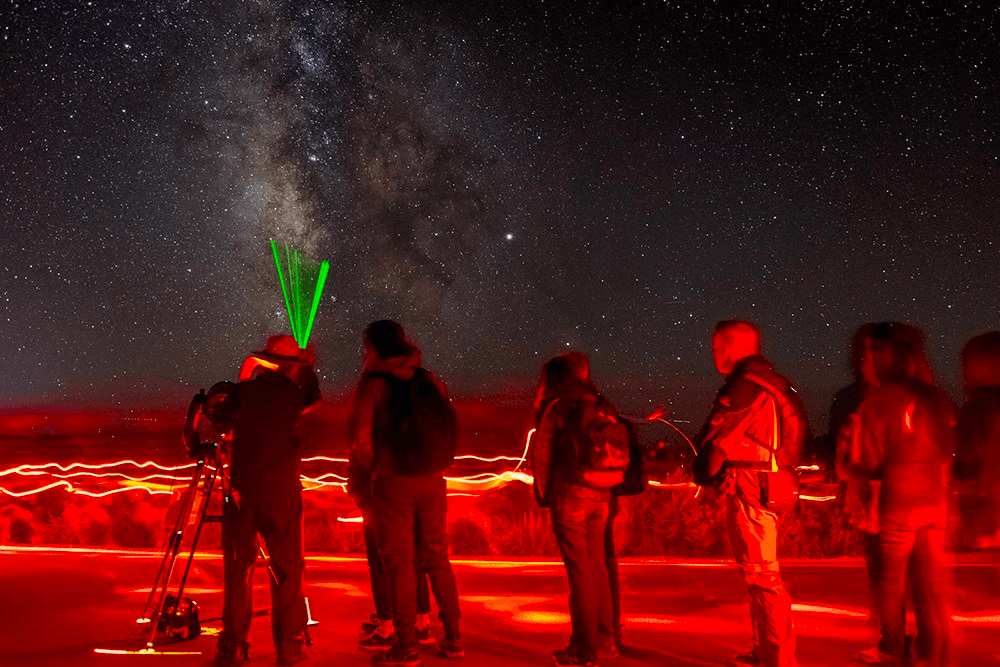
การขนส่ง
💡 การมีรถยนต์ถือเป็นสิ่งจำเป็นอย่างมากหากคุณวางแผนจะไปเที่ยวสวนสาธารณะ
การเดินทางไปยังสวนสาธารณะ
การเดินทางไปยังอุทยานแห่งชาติอาร์เชสเป็นเพียงจุดเริ่มต้นของการผจญภัยของคุณ วิธีการเดินทางที่พบบ่อยที่สุดในการไปยังอุทยานคือรถยนต์ หากคุณเดินทางมาเยี่ยมชมอุทยานจากรัฐอื่น คุณสามารถพิจารณาบินไปยังสนามบินแห่งใดแห่งหนึ่งต่อไปนี้:
✈️ สนามบินภูมิภาค Canyonland Field: ขับรถ 15 นาทีถึงสวนสาธารณะ
✈️ สนามบินภูมิภาค Grand Junction: ขับรถ 1.5 ชั่วโมงสู่สวนสาธารณะ
✈️ สนามบินนานาชาติซอลท์เลคซิตี้: ขับรถ 3.5 ชั่วโมงถึงสวนสาธารณะ
การขนส่งภายในสวนสาธารณะ
ไม่มีระบบขนส่งสาธารณะภายในอุทยาน หากต้องการเดินทาง คุณจะต้องขับรถ ปั่นจักรยาน หรือออกทัวร์ หากคุณต้องการชมดาวโดยเฉพาะ การขับรถถือเป็นสิ่งสำคัญอย่างยิ่ง เนื่องจากจุดชมดาวที่ดีที่สุดมักอยู่ไกลจากทางเข้าหลัก อย่างไรก็ตาม เนื่องจากที่จอดรถอาจมีจำกัด โดยเฉพาะในช่วงฤดูท่องเที่ยวสูงสุด ควรพิจารณาใช้รถร่วมกันหากเป็นไปได้
เวลาที่ดีที่สุดในการเยี่ยมชม
เวลาที่ดีที่สุดในการดูดาวคือเมื่อคุณไม่สามารถมองเห็นดวงจันทร์ได้และท้องฟ้าจะมืดที่สุด ซึ่งก็คือช่วงเวลารอบดวงจันทร์ใหม่ คุณสามารถตรวจสอบได้ค้นพบโมอับเพื่อดูข้อมูลเพิ่มเติมเกี่ยวกับข้างขึ้นข้างแรม
อย่างไรก็ตาม สวนสาธารณะแห่งนี้เปิดให้บริการตลอดทั้งปี ดังนั้นคุณจึงสามารถวางแผนการเยี่ยมชมได้ตลอดทั้งปี สวนสาธารณะแห่งนี้ได้รับความนิยมมากที่สุดในช่วงฤดูร้อน หรือในช่วงฤดูใบไม้ผลิและฤดูใบไม้ร่วงในเดือนเมษายนถึงพฤษภาคมหรือกันยายนถึงตุลาคม ซึ่งเป็นช่วงที่สภาพอากาศสบายกว่า
หากคุณต้องการหลีกเลี่ยงฝูงชนโดยสิ้นเชิง ควรมาเที่ยวในช่วงฤดูหนาว แม้ว่าคุณจะต้องเตรียมใจที่จะทนกับความหนาวเย็นก็ตาม
สถานที่ที่ดีที่สุดในการดูดาว
มีพื้นที่หลายแห่งในอุทยานที่คุณสามารถชมดาวได้ คำแนะนำทั่วไปบางประการที่จะช่วยให้คุณค้นหาจุดชมดาวได้ ได้แก่ อย่าเข้าใกล้ถนนสายหลักที่มีรถยนต์จำนวนมาก มองหาจุดชมวิวที่สูงหรือบริเวณโล่งกว้าง และยิ่งคุณขับรถไปทางเหนือมากขึ้นเท่าใด ท้องฟ้าก็จะยิ่งมืดลงเท่านั้น และยิ่งเหมาะกับการชมดาวมากขึ้นเท่านั้น

ต่อไปนี้เป็นจุดชมดาวที่ดีที่สุดในสวนสาธารณะ:
พื้นที่ปิกนิกบาลานซ์ร็อค
Balanced Rock เป็นจุดที่โดดเด่นที่สุดแห่งหนึ่งของอุทยานแห่งชาติ Arches ฝั่งตรงข้ามถนนสายหลักของ Balanced Rock มีพื้นที่ปิกนิกขนาดใหญ่ ซึ่งได้รับการแนะนำจากหน่วยงานอุทยานแห่งชาติว่าเป็นจุดชมดาวที่ดีที่สุดแห่งหนึ่ง ห่างจากทางเข้าเพียง 20 นาทีหากเดินทางโดยรถยนต์ นอกจากนี้ยังเป็นจุดที่เข้าถึงได้สะดวกที่สุดอีกด้วย
**จุดชมวิวสวนเอเดน**
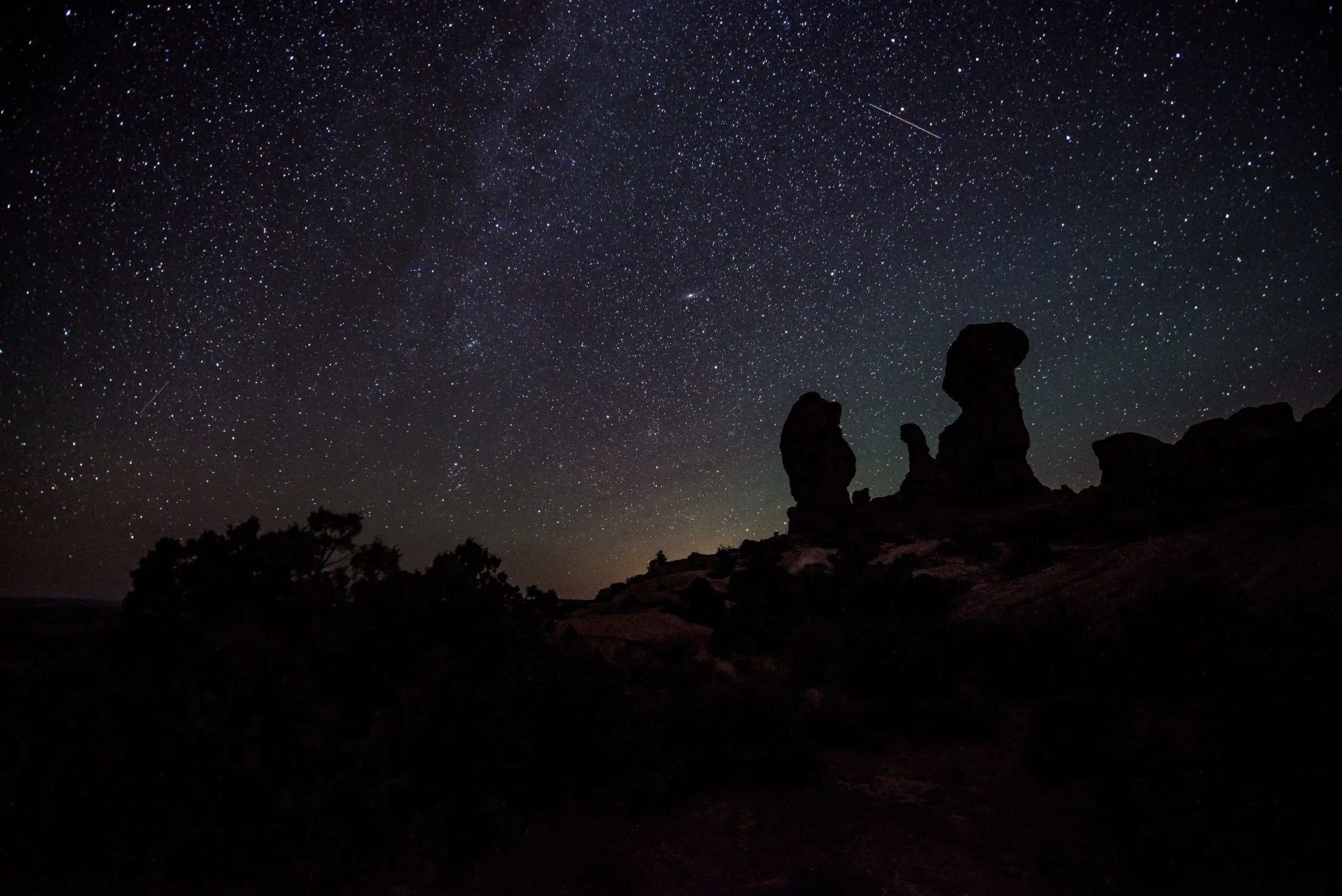
จุดชมวิว Garden of Eden เป็นอีกสถานที่หนึ่งที่กรมอุทยานแห่งชาติแนะนำสำหรับการดูดาว เมื่อเทียบกับ Balanced Rock ที่เป็นสัญลักษณ์ จุดชมวิว Garden of Eden มักจะมีผู้คนพลุกพล่านน้อยกว่ามาก จึงเหมาะสำหรับผู้ที่ต้องการใช้เวลากลางคืนอันเงียบสงบใต้แสงดาว
หมวดหน้าต่าง
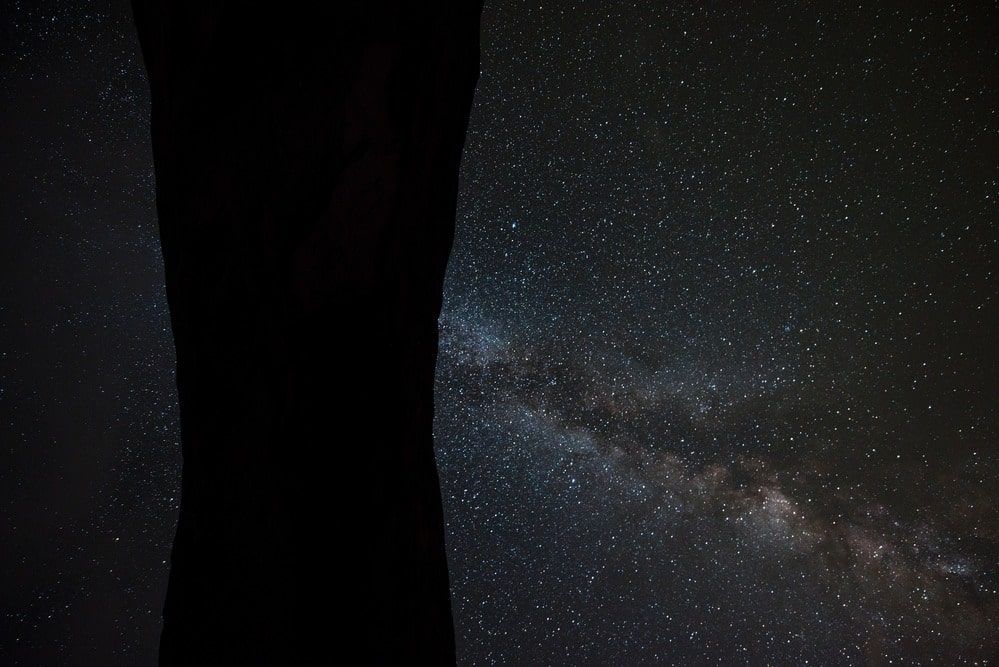
ส่วนหน้าต่างเป็นหนึ่งในสถานที่ท่องเที่ยวที่ได้รับความนิยมมากที่สุดในอุทยาน แต่ยังเป็นจุดชมดาวที่ดีที่สุดอีกด้วย อยู่ห่างจากทางเข้าเพียง 30 นาทีโดยรถยนต์ แต่ก็อยู่ไกลจากมลภาวะแสงเพียงพอที่จะเพลิดเพลินกับท้องฟ้าที่มืดมิด ที่นี่ คุณสามารถมองขึ้นไปบนทางช้างเผือกผ่านซุ้มประตูหน้าต่างด้านเหนือและด้านใต้ ท้องฟ้าที่มืดมิดของอุทยานเป็นฉากหลังที่สมบูรณ์แบบสำหรับการชมกลุ่มดาว และซุ้มประตูยังเพิ่มองค์ประกอบพิเศษที่สร้างความมหัศจรรย์ให้กับประสบการณ์นี้ ส่วนหน้าต่างยังเป็นจุดยอดนิยมสำหรับการชมพระอาทิตย์ตกอีกด้วย
จุดชมวิว

จุดชมวิวพาโนรามาเป็นจุดชมดาวยอดนิยมแห่งหนึ่ง และมักเป็นจุดที่เจ้าหน้าที่อุทยานจัดโปรแกรมชมดาวให้ด้วย ที่จุดชมวิวพาโนรามา คุณจะมองเห็นทิวทัศน์กว้างไกลสุดสายตาในทุกทิศทาง จึงเป็นจุดยอดนิยมสำหรับการถ่ายภาพท้องฟ้ายามค่ำคืน นอกจากนี้ ที่จุดชมวิวพาโนรามายังมีพื้นที่ปิกนิกอีกด้วย
จุดชมวิวซุ้มโค้งอันบอบบาง
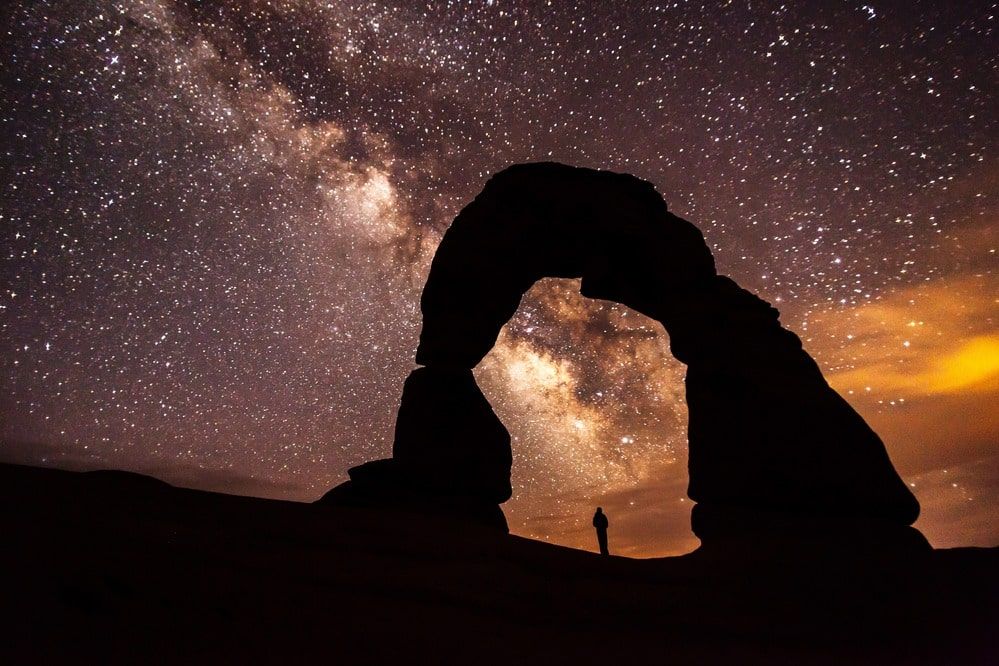
Delicate Arch เป็นหนึ่งในจุดเด่นที่สุดของอุทยานแห่งนี้ แม้จะดูงดงามในตอนกลางวัน แต่เมื่อตกกลางคืนและท้องฟ้าเต็มไปด้วยดวงดาว คุณจะได้ชมทิวทัศน์ที่สวยงามตระการตาอีกมุมหนึ่ง แต่ถ้าคุณไม่อยากเดินขึ้นไปที่ซุ้มประตู โดยเฉพาะตอนกลางคืน ให้ไปที่จุดชมวิว Delicate Arch จากจุดชมวิวนี้ คุณจะมองเห็น Delicate Arch ได้อย่างสวยงาม แม้ว่าจะมองจากระยะไกลก็ตาม อย่าลืมพกกล้องส่องทางไกลไปด้วยหากต้องการดูซุ้มประตูจากจุดชมวิวนี้ นอกจากนี้ คุณยังจะได้ชมพระอาทิตย์ขึ้นที่สวยงามที่สุดที่จุดชมวิว Delicate Arch อีกด้วย
สนามกางเต็นท์ Devil’s Garden
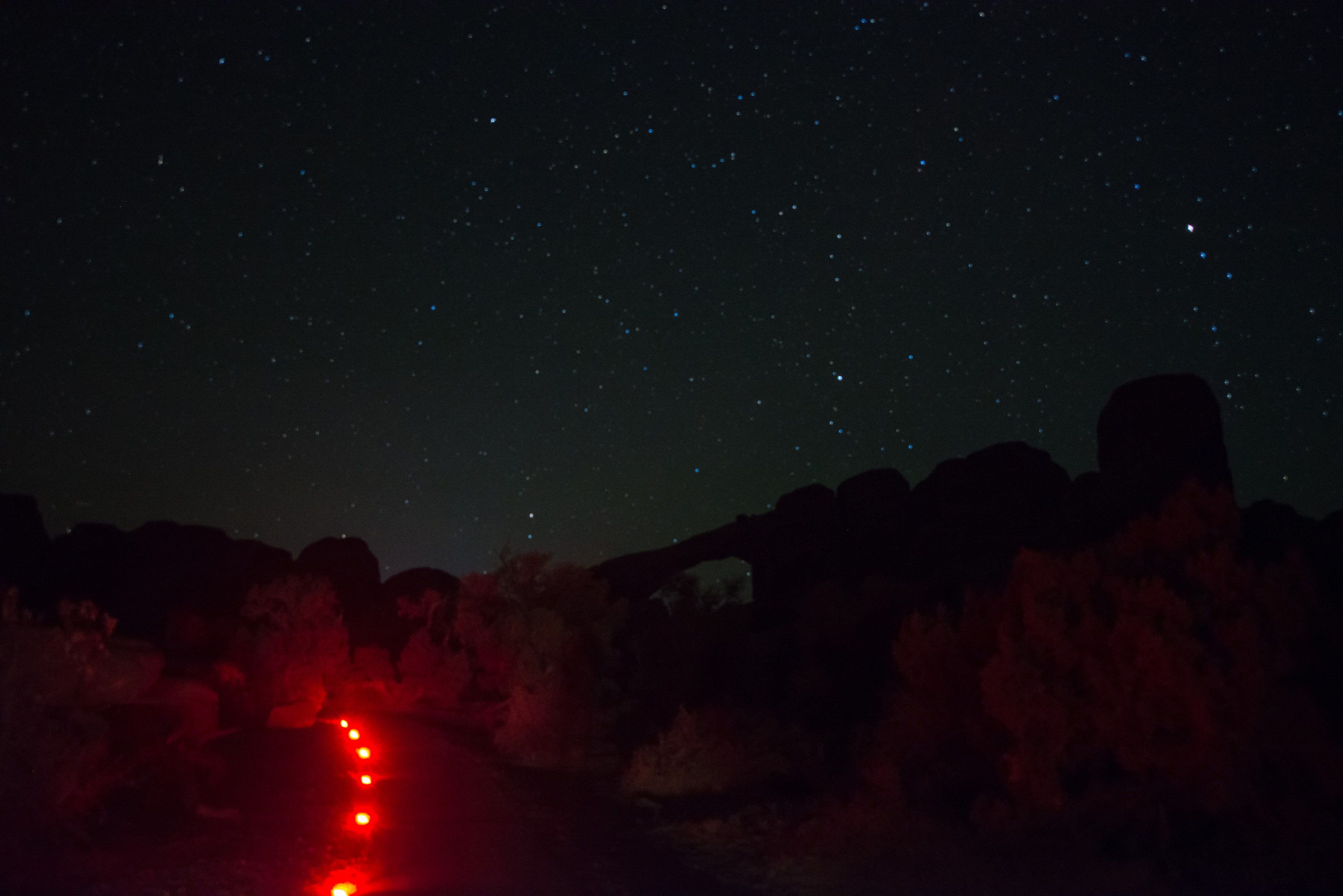
Devil’s Garden Campground เป็นพื้นที่กางเต็นท์แห่งเดียวในอุทยานแห่งชาติ Arches และมักถูกจองเต็มล่วงหน้าหลายเดือน หากคุณเป็นหนึ่งในผู้โชคดีที่ได้จองพื้นที่กางเต็นท์แห่งนี้ คุณสามารถข้ามขั้นตอนการขับรถไปรอบๆ อุทยานแห่งชาติและเพลิดเพลินกับท้องฟ้ายามค่ำคืนจากพื้นที่กางเต็นท์ของคุณได้อย่างสบายๆ!
พักที่ไหน

หากคุณจะนอนดึกเพื่อดูดวงดาวและต้องการประสบการณ์ที่เต็มอิ่มอย่างแท้จริง ลองพิจารณาตั้งแคมป์ใกล้กับอุทยาน หรือดีกว่านั้นก็คือในอุทยาน นี่คือคำแนะนำสำหรับตัวเลือกการตั้งแคมป์บางส่วน:
สนามกางเต็นท์ Devil’s Garden
Devil’s Garden Campground เป็นพื้นที่กางเต็นท์แห่งเดียวในอุทยาน ในช่วงฤดูท่องเที่ยวสูงสุดระหว่างเดือนมีนาคมถึงตุลาคม คุณจะต้องจองมีที่ว่างให้จองล่วงหน้า ตั้งแต่เดือนพฤศจิกายนถึงเดือนกุมภาพันธ์ พื้นที่กางเต็นท์จะเปิดให้บริการตามลำดับก่อนหลัง หากคุณวางแผนจะกางเต็นท์ที่ Devil’s Garden Campground โปรดทราบว่าไม่มีร้านค้าในแคมป์ ดังนั้นคุณจะต้องเตรียมอุปกรณ์ให้พร้อม นอกจากนี้ ควรทราบด้วยว่าสัญญาณโทรศัพท์มือถือที่ไซต์อาจไม่ค่อยดีนัก
ซัน เอาท์ดอร์ อาร์เชส เกตเวย์
ซัน เอาท์ดอร์ อาร์เชส เกตเวย์เป็นพื้นที่กางเต็นท์ที่ตั้งอยู่ใกล้กับอุทยานแห่งชาติ Arches มีพื้นที่จอดรถบ้านและเต็นท์ แต่ถ้าคุณไม่มีอุปกรณ์กางเต็นท์เป็นของตัวเองแต่ยังอยากสัมผัสประสบการณ์การกางเต็นท์ คุณจะต้องดีใจที่ทราบว่า Sun Outdoors Arches Gateway ยังมีกระท่อมและรถตู้ให้เช่าอีกด้วย! เมื่อเทียบกับ Devil’s Garden Campground แล้ว Sun Outdoors Arches Gateway มีร้านค้าและสิ่งอำนวยความสะดวกอื่นๆ ครบครันกว่ามาก เหมาะสำหรับผู้ที่ต้องการความหรูหราท่ามกลางธรรมชาติ
วันหยุดที่ Moab KOA
วันหยุด KOAเป็นองค์กรที่มีชื่อเสียงซึ่งมีพื้นที่กางเต็นท์มากมายทั่วสหรัฐอเมริกา ไม่น่าแปลกใจเลยที่พวกเขามีสถานที่กางเต็นท์ที่เมืองโมอับ ใกล้กับอุทยานแห่งชาติอาร์เชส นอกจากพื้นที่จอดรถบ้านแล้ว พื้นที่กางเต็นท์ยังมีกระท่อมให้เช่าสำหรับผู้ที่ไม่มีอุปกรณ์ตั้งแคมป์ของตัวเองอีกด้วย พวกเขายังมีร้านค้าสำหรับตั้งแคมป์เพื่อให้คุณหยิบของใช้ที่จำเป็นได้
แต่หากท่านกำลังมองหาที่พักที่หรูหราและสะดวกสบายยิ่งขึ้น ก็ยังมีโรงแรมใกล้สวนสาธารณะอีกหลายแห่งที่ให้ท่านเลือกได้ เช่น:
- โรงแรมฮอลิเดย์ อินน์ เอ็กซ์เพรส แอนด์ สวีท โมอับ
- ไฮแอทเพลส โมอับ
- แฟร์ฟิลด์ อินน์แอนด์สวีทส์ บาย แมริออท โมอับ
- คอมฟอร์ตสวีท โมอับ
สิ่งที่ควรทราบก่อนเดินทาง
- อุทยานแห่งชาติอาร์เชสเป็นอุทยานแห่งชาติที่ได้รับความนิยมอย่างมากและคาดว่าจะมีนักท่องเที่ยวจำนวนมาก เพื่อช่วยจัดการฝูงชนตั๋วเข้าชมแบบกำหนดเวลาจำเป็นสำหรับการเข้าชมในช่วงเดือนเมษายนถึงตุลาคม และเปิดให้จองล่วงหน้าได้ถึงสามเดือน จำเป็นต้องมีบัตรเข้าชมแบบระบุเวลาเพื่อเข้าชมระหว่างเวลา 07.00 น. ถึง 16.00 น. แต่หากคุณเข้าชมในเวลากลางคืนเพื่อดูดาว คุณอาจต้องเข้าชมนอกช่วงเวลาดังกล่าว และไม่จำเป็นต้องมีบัตรเข้าชม
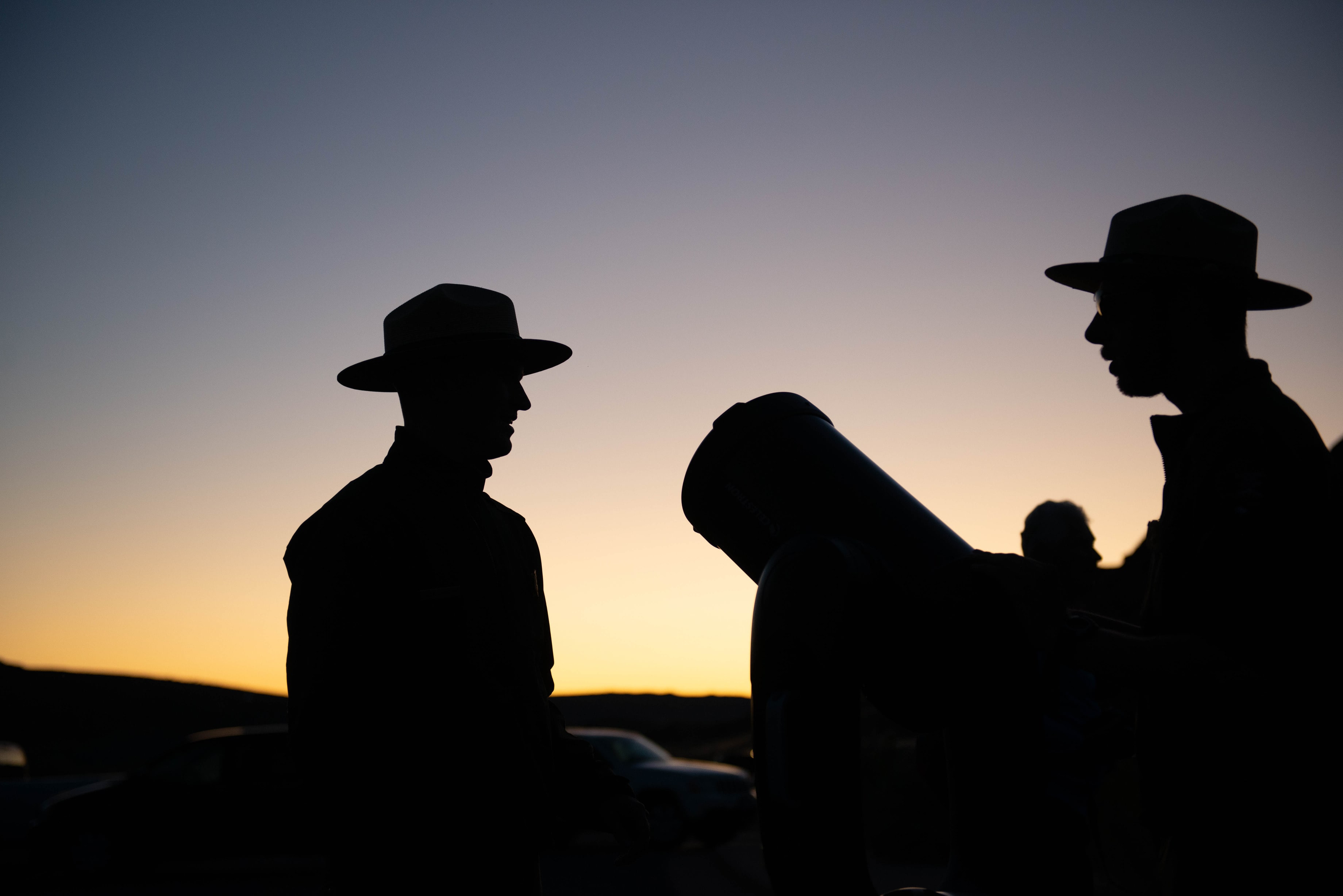
- อุทยานแห่งชาติอาร์เชสจะมีกิจกรรมดูดาวเป็นครั้งคราว ซึ่งนำโดยเจ้าหน้าที่พิทักษ์ป่า กิจกรรมเหล่านี้มักจะจัดขึ้นในช่วงฤดูใบไม้ผลิและฤดูใบไม้ร่วงในช่วงวันขึ้น 1 ค่ำ และจะกินเวลานาน 1-3 ชั่วโมง คุณสามารถเยี่ยมชมศูนย์บริการนักท่องเที่ยวเพื่อดูรายละเอียดเพิ่มเติมเกี่ยวกับตารางเวลาและกิจกรรมต่างๆ หากคุณโชคดีพอที่จะได้เยี่ยมชมอุทยานในวันที่มีกิจกรรมนี้ เราขอแนะนำให้คุณเข้าร่วมกิจกรรมเพื่อสัมผัสประสบการณ์ดูดาวที่ให้ข้อมูลมากขึ้น
- ควรระมัดระวังเป็นพิเศษและอย่าเดินบนเส้นทางในอุทยาน ควรเดินบนเส้นทางเสมอเพื่อปกป้องเปลือกดินที่เปราะบางและแหล่งที่อยู่อาศัยตามธรรมชาติ โดยเฉพาะในเวลากลางคืนซึ่งมีทัศนวิสัยไม่ดี ควรเดินบนเส้นทางด้วยเพื่อลดความเสี่ยงในการบาดเจ็บหรือหลงทาง
- โปรดคำนึงถึงผู้อื่นและช่วยกันรักษาความมืดตามธรรมชาติ อย่าส่องไฟฉายไปที่หินรูปร่างต่างๆ หรือบริเวณอื่นๆ
- ช่วยรักษาสิ่งแวดล้อมธรรมชาติ - เก็บขยะไปด้วยและอย่าทิ้งรอยไว้บนหิน!
เคล็ดลับ
การดูดาวในทะเลทรายอาจต้องมีการเตรียมตัวบ้าง ต่อไปนี้คือเคล็ดลับบางประการที่จะช่วยให้คุณเตรียมตัวสำหรับการมาเยือนของคุณได้:
- นำเสื้อผ้าที่อบอุ่นมาด้วยและสวมเสื้อผ้าหลายชั้น เนื่องจากอุณหภูมิระหว่างกลางวันและกลางคืนอาจแตกต่างกันอย่างมาก
- อย่าลืมพกน้ำดื่มไปด้วย โดยเฉพาะหากคุณมาเที่ยวในช่วงฤดูร้อน ทะเลทรายแห่งนี้แห้งแล้งมาก ดังนั้นคุณจึงควรดื่มน้ำให้เพียงพอ
- เตรียมอาหารเบาๆ ไว้ด้วย เนื่องจากในสวนสาธารณะไม่มีร้านอาหาร คุณจึงควรเตรียมอาหารไว้บ้างในกรณีที่หิว
- นำไฟฉายสีแดงหรือไฟคาดศีรษะมาด้วยเพื่อช่วยปกป้องดวงตาของคุณในเวลากลางคืน หากไม่มีไฟฉายสีแดง ให้ใช้ผ้าสีแดงหรือเซลโลเฟนมาคลุมไฟฉายสีขาวของคุณ
- นำกล้องส่องทางไกลมาด้วยเพื่อชมดวงดาว
- ให้ดวงตาของคุณปรับตัวเข้ากับความมืดและอดทน คุณอาจต้องรอประมาณ 20 ถึง 30 นาทีเพื่อให้ดวงตาของคุณปรับตัวเข้ากับความมืดได้อย่างเต็มที่ เมื่อดวงตาของคุณปรับตัวได้แล้ว คุณจะสามารถมองเห็นทางช้างเผือก ดาวตก และสิ่งมหัศจรรย์บนท้องฟ้าอื่นๆ ได้
- นำแผนที่ดาวมาด้วยเพื่อช่วยคุณระบุกลุ่มดาวต่างๆ!